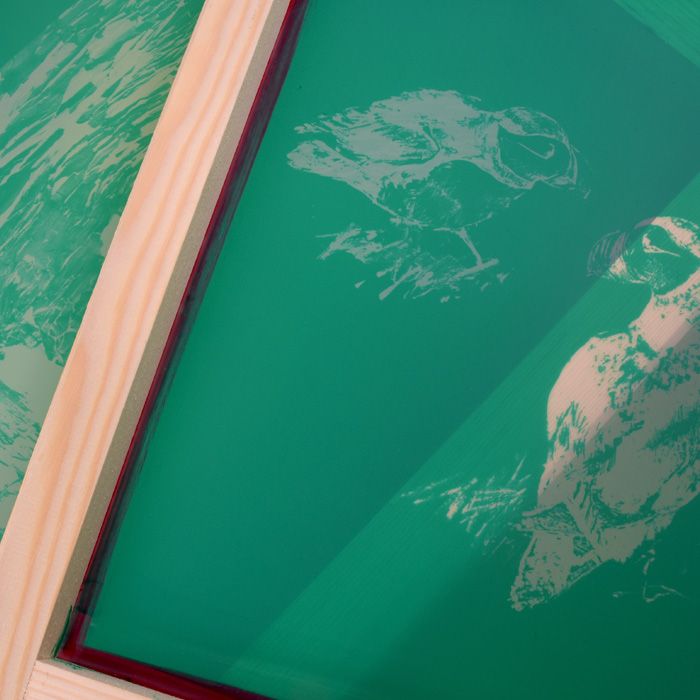Screen Printing Uncovered: Whatever You Required to Know Concerning Tee and Garment Printing Techniques
If you've ever wondered how those dynamic designs end up on your preferred tee shirts, you're in the best location. Display printing is an interesting technique that integrates art with method, supplying endless opportunities for creative thinking. Understanding the fundamentals, from tools to ink options, can considerably influence your results. All set to check out the essential elements that make screen publishing an art kind? Allow's discover the details that can elevate your tasks.
The Basics of Display Printing: Exactly How It Functions
When you dive right into screen printing, you'll discover it's both a science and an art. At its core, screen printing involves developing a stencil, or display, that enables ink to travel through only in particular locations (screen printing kit). You begin by choosing your layout and preparing your screen with a light-sensitive solution. Once you reveal this emulsion to light, it solidifies, leaving your design as an adverse area.
Next, you'll blend your inks and prepare your printing surface. Position the display over the fabric, then make use of a squeegee to push ink with the screen onto the garment. This process requires accuracy, as you desire clear, vivid prints. After printing, you'll heal the ink with heat, ensuring it abides by the textile and lasts through laundries. Each action is essential, and mastering them will raise your display printing skills, transforming basic garments into special, meaningful items.
Types of Screen Printing Strategies
When you realize the essentials of display printing, it's time to check out the various methods that can elevate your designs. One preferred technique is typical display printing, where ink is pushed through a stenciled screen.
An additional alternative is plastisol printing, recognized for its longevity and vibrant colors, making it a favorite for lots of brands. Experiment with halftone printing to create gradient results and complex layouts.
Crucial Devices for Display Printing
To achieve stunning results in screen printing, having the right tools is fundamental. You'll need a durable screen printing framework, which holds the mesh that moves your layout onto the garment. Next off, spend in top quality mops; these are crucial for using ink equally throughout the display.
Choosing the Right Inks and Products
When picking inks and products for display printing, you require to consider the kind of ink that functions finest for your task. Assume concerning material compatibility to ensure your styles look last and great lengthy. Additionally, discover environment-friendly ink choices to make your printing process more sustainable.
Sorts Of Screen Inks
Picking the ideal screen ink is crucial for accomplishing dynamic, sturdy prints that meet your job's needs. There are numerous types of display inks to analyze. Plastisol ink is popular for its flexibility and ease of usage, providing exceptional shade opacity on dark fabrics. Water-based ink, on the various other hand, supplies a softer feeling and is green, making it ideal for those wanting to lessen their ecological impact. Discharge inks get rid of color from the material, causing a soft, vintage appearance yet require certain handling. Ultimately, specialized inks, such as metal or glow-in-the-dark, can add distinct impacts to your layouts. Examine your project demands and choose the ink that aligns finest with your desired result.

Textile Compatibility Factors To Consider
Recognizing textile compatibility is vital for achieving high-grade display prints, particularly given that different materials react distinctly to numerous inks. Always test your inks on example material to ensure they adhere correctly and preserve color integrity. In addition, maintain in mind that textile weight and structure can impact the final result, so picking the ideal ink and product combination is important for your task's success.
Eco-Friendly Ink Options
Environmentally friendly inks are ending up being a preferred selection for screen printers that want to reduce their ecological impact while preserving quality. When selecting inks, think about water-based inks, which are less harmful and much easier to clean up compared to standard solvents.
Furthermore, try to find inks made from sustainable sources, such as soy or vegetable-based choices. By selecting the right inks and materials, you'll not only create magnificent layouts but likewise add to a more sustainable printing procedure. Make the button, and your prints will mirror your commitment to the atmosphere!
Preparing Your Style for Screen Printing

File Style Requirements
To guarantee your layout looks sharp and vivid on textile, you'll require to pay close focus to file format needs for screen printing. Make certain your design has a transparent history to prevent undesirable white sides on your prints. Maintain shade settings in mind; CMYK is basic for display printing, so convert your RGB designs accordingly.
Shade Separation Methods
Color separation is a necessary action in preparing your design for screen printing, and grasping it can considerably improve your print top quality. You'll need to damage your design right into private shades, as each color needs a separate display throughout printing. Start by determining all the colors in your layout and develop layers each. You can make use of software program like Adobe Photoshop or Illustrator to separate and separate colors successfully. Be particular to conserve each layer as a separate documents, commonly in a format like TIFF or PSD. This accuracy not only guarantees accurate shade depiction but also enhances the printing procedure. By paying attention to shade separation, you'll attain expert and vibrant cause your screen-printed garments.
Resolution and Size
Attaining the most effective outcomes in screen printing begins with guaranteeing your design has the ideal resolution and size. Preferably, your art work should be at the very least 300 DPI (dots per inch) for sharp, clear prints. Your last product might look unprofessional and pixelated. if you utilize reduced resolution.
When it involves size, take into consideration the measurements of your print area. Design your art work to match the final print dimension, ideally producing it in the actual dimensions you'll be printing. In this manner, you'll prevent any type of unexpected scaling problems.
Constantly blog here check your style in both vector and raster styles. Vector graphics can be scaled without losing high quality, making them ideal for display printing. Preparing correctly will ensure your layout looks impressive a knockout post on every garment!
Step-by-Step Display Printing Refine
Screen printing is a vibrant procedure that enables you to develop vivid designs on numerous surfaces. To get going, you'll need a screen, emulsion, and your chosen ink. First, prepare your display by cleaning it completely. Next off, apply the solution uniformly and allow it dry in a dark area. Once completely dry, subject your display to light with your style put on it, which will certainly solidify the solution where the light hits, developing a stencil - screen printing kit.
Pour ink onto the display and make use of a squeegee to press the ink with the pattern onto the textile. Raise the display carefully and allow the print completely dry. You have actually efficiently screen printed your layout.
Tips for Successful Screen Printing Projects
While you're diving into your display printing projects, bear in mind that preparation is key to success. Start by gathering all your products-- inks, garments, screens, and mops. A tidy work space helps prevent unwanted mistakes, so clean before you start.
Following, confirm your art work is high-resolution and properly sized for your garment. Test your display for appropriate direct exposure and clean it extensively to avoid spots. When blending your inks, follow the manufacturer's standards to achieve the appropriate consistency.
During printing, use also pressure with your squeegee for regular outcomes. Do not hurry; take your time to confirm each print fulfills your standards. After printing, allow your garments dry completely prior to dealing with or packaging them.
Finally, constantly maintain a sample of your benefit future recommendation. In this manner, you can analyze your progress and improve your methods over time. Pleased printing!

Often Asked Questions
How much time Does It Take to Establish a Screen Printing Job?
Establishing a screen printing task usually takes around thirty minutes to an hour. You'll prepare the displays, mix inks, and change the press. The time varies based upon intricacy and experience, so remain arranged!
Can I Print on Different Material Keys In Using the Same Strategy?
Yes, you can print on various textile kinds using the exact same method, however you'll need to adjust your inks and setups. Some materials take in ink in a different way, so trying out assurances the most effective results for each and every product.
What Prevail Mistakes to Stay Clear Of in Screen Printing?
When display printing, prevent typical errors like using the incorrect ink, overlooking proper direct exposure times, or avoiding pre-press checks. Constantly examine your setup and preserve tidy displays to guarantee top quality results each time.
Just How Can I Appropriately Clean and Preserve My Display Printing Tools?
To appropriately clean and maintain your display printing tools, you must on a regular basis wash screens with suitable solvents, examine squeegees for wear, and ensure all devices are saved dust-free and dry. Consistency enhances and avoids expensive repair work efficiency.
Is Display Printing Environmentally Friendly Compared to Other Techniques?
Screen printing can be extra eco-friendly than other approaches, particularly if you utilize water-based inks and eco-conscious materials. By picking lasting materials and practices, you decrease waste and minimize your influence on the earth.
Display Printing Uncovered: Every Little Thing You Required to Know Concerning T-Shirt and Garment Printing Strategies
At its core, screen printing includes producing a stencil, or screen, that allows ink to pass via just in details locations. Setting the display over the fabric, then make use of a squeegee to press ink through the screen onto the garment. One preferred method is conventional display printing, where ink is pushed through a stenciled screen.When choosing inks and materials for display printing, you require to take into account the type of ink that works ideal for your job.
Comments on “High-Quality Custom Screen Printing for Team Apparel”